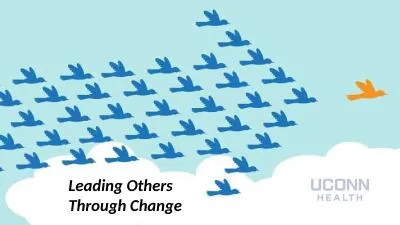

Agenda Overview of Change Change versus Transition Teams in Transition Approach to Change Summary Change Part of life Impossible to avoid Creates stress Involves both loss and growth ID: 913937
Download Presentation The PPT/PDF document "Leading Others Through Change" is the property of its rightful owner. Permission is granted to download and print the materials on this web site for personal, non-commercial use only, and to display it on your personal computer provided you do not modify the materials and that you retain all copyright notices contained in the materials. By downloading content from our website, you accept the terms of this agreement.
Slide1
Leading Others Through Change
Slide2Agenda
Overview of Change
Change versus Transition
Teams in Transition
Approach to ChangeSummary
Slide3Change . . .
Part of lifeImpossible to avoidCreates stress
Involves both loss and growth
Can be a crisis and an opportunity
Slide4Change versus TransitionChange is situational and is external to us
i.e. new job/boss, marriage, death of a loved one, divorce, birth of a child, downturn in economy, move to a new place, illnessTransition is the process of adapting
to the change
Slide5Think about the times you’ve movedHow long did it take for you to move your “stuff” from point A to point B?
How long did it take you to feel at home?
Change is an event; Transition is a process
Slide6Common Reactions to ChangeDenialResistance
IsolationSadnessDetachment
Anger
Interpersonal conflicts
Communication issuesInsecurityLoss of ControlDecreased motivation
Wish for things to go back to how they were
Reactions to change are individual and depend on a variety of factors, such as life experience, personal values, cultural background, gender influences, personality style, and stage of life
Slide7Dynamics of ChangeNo matter how exciting or necessary the change….
There is a sense of LossNo matter how skilled people are….
There is a sense of Confusion and Uncertainty
To varying degrees and at various stages…. Expect ResistanceNo matter how carefully the change was implemented ...
People will feel a loss of control
Slide8Losses Associated with ChangeLoss of the Known and Tried
Loss of ControlLoss of StructureLoss of Predictable/ComfortableLoss of Future
Loss of Attachments
Loss of Turf
Loss of MeaningLoss of Future
Slide9Slide10Reflecting/Anticipating ChangesIdentify workplace changes that have occurred over the past yearStaffing
Roles/responsibilitiesQuantity of workType/methods of work
Technological changes
Challenging events
Celebrations/accomplishmentsWhat changes do you anticipate in the next 6 months?
Slide11Teams in TransitionJust as each person has his/her own individual reaction to change, the team is going through a similar transitionThe four main stages of teams in transition are:
Denial, Resistance, Exploration, and CommitmentPeople on the team may be in different stages at the same time
Slide12DenialEmployees attempt to deny or minimize the impact of the changeSigns of denial may include people avoiding the topic, going through the motions, pretending nothing is happening
You may hear:“They don’t really mean it”“They’ll go back to the old way”
“It’s no big deal; everything will be fine”
Slide13ResistanceDenial is often followed by a period of resistance, when things seem to get worse, and people may feel increasingly apprehensive and irritatedSigns of Resistance may include mistakes, careless work, anger, low energy, distraction
You may hear:“They can’t do this to me! It isn’t fair!”“This should never have happened.”
“I’m afraid I won’t be able to do this”
Slide14ExplorationPeople begin to shift to a more positive, optimistic phase and feel more confident that they will survive the change. They feel more motivated to explore new possibilitiesSigns of Exploration may include confusion, increased training, trying new things
You may hear“I’ve got an idea to try.”“Maybe this will work out after all.”
“This works better than the old way.”
Slide15In this final stage, a new sense of cohesion starts to emerge. People are ready to work together to create new stability. There is a sense of pride in having mastered the challenge
Signs of Commitment may include independent decision making, cooperation and improved teamworkYou may hear:
“We’ve come a long way.”
“How can we work together on this?”
“We’re going to be the best team around.”Commitment
Slide16Slide17What employees need in each stage…
Slide18Helping Employees Through Change Provide information – Communicate, communicate, communicate!Explain how the change fits into the overall mission
Ask for questions, concerns, feelings, opinionsResist becoming defensiveBe visible and involvedLook for opportunities for employee inputRecognize individual differences
Be patient!
Slide19What to Avoid Autocratic behaviorAvoiding employeesDismissing other’s concernsRah! Rah! Jumping ahead too quickly
Assuming others will react the same way you do to changeIgnoring your own needsGoing it alone
Slide20As you face changes in your life…Look at what’s ending and acknowledge your losses
Understand and try to accept that there will be periods of uncertainty and heightened emotionLook to your experience in dealing with change in the past to help deal with present changes
Adopt
the attitudes and behaviors that can help you move forward in a positive direction
Identify what you can control and what you cannotChoose to take action on the things you can, and let go of the things you can’t
Slide21Remember. . .
Smooth seas do not make skillful sailors. ~African Proverb